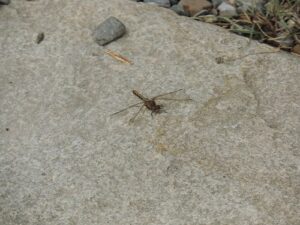Winter presents many challenges to all of us living here in the north, but for insects these challenges are particularly unique. Insects have a very different makeup from mammals and plants in that they are essentially a liquid-filled box. All insects have 3 main body regions (head, thorax, and abdomen), 3 pairs of jointed legs, and one pair of antennae. Most have 2 pairs of wings. Because an insect has its skeleton on the outside (an exoskeleton) the internal organs are basically floating in a water- like liquid called hemolymph.
Insects respond to cooling temperatures in a variety of ways and different species show different levels of sensitivity to freezing temperatures. Mammals can generate their own heat and have the advantage of being large. Insects are small and do not have body fat for insulation from the cold and do not produce their own heat. However, they do have several general strategies which they can imploy such as migration, dormancy, and physiological escapes for dealing with winter.
Because of their small body size, few insects migrate long horizontal distances. However, the monarch butterflies, which migrate from continental United States to as far south as Mexico and the Yucatan, are an incredible exception to this. Some insects have a vertical migration, by digging into the ground or following small cracks to areas deep below the frost line for protection, areas for protection but this strategy is also fairly uncommon. Dormancy is a common strategy for overwintering in a variety of developmental stages including as eggs, larvae and pupae. These overwintering stages are often deposited in protected spaces deep in the leaf litter, under tree bark, or as insect galls located on willow branches. Many aquatic insects over winter in pond and lake mud (like the wood frog).

But the most exciting escapes from freezing are physiologic. Some species of insects over winter in the adult stage and avoid freezing damage to their body by making a sort of biologic antifreeze material. These insects synthesize compounds such as sugars and proteins which depress the freezing point. These chemicals are called cryoprotectants, such as glycerol – similar to the stuff we pour down our sinks to prevent freezing! As temperatures increase, cryoprotectants quickly decrease. Some insects, like many plants, undergo a cold-hardening when shorter days and cooler temperatures occur. The mechanisms providing over winter cold-hardiness results from a combination of supercooling and the insect- manufactured cryoprotectants, which here in Alaska can protect species down to -76 degrees F.
One aspect of the freezing point of supercooled water is dependent on the size – the smaller the drop of water the lower the freezing point. In the body of an insect some drops of water are intracellular and others extracellular, but all drops are small and freeze at a lower temperature. The combination of producing chemicals which are cryoprotectants, and the supercooling ability of smaller drops of water, is only part of the unique physiologic escape from winter by some insects. It is a fascinating and complex biology by simple little creatures often overlooked and under-appreciated. Insects are important plant pollinators as well as indicators of ecological quality in our environment. They fill important roles in the food chain, and very few species compete for plants that people value. Consequently, they may avoid “predator control” and intensive management in this state, at least for awhile.



